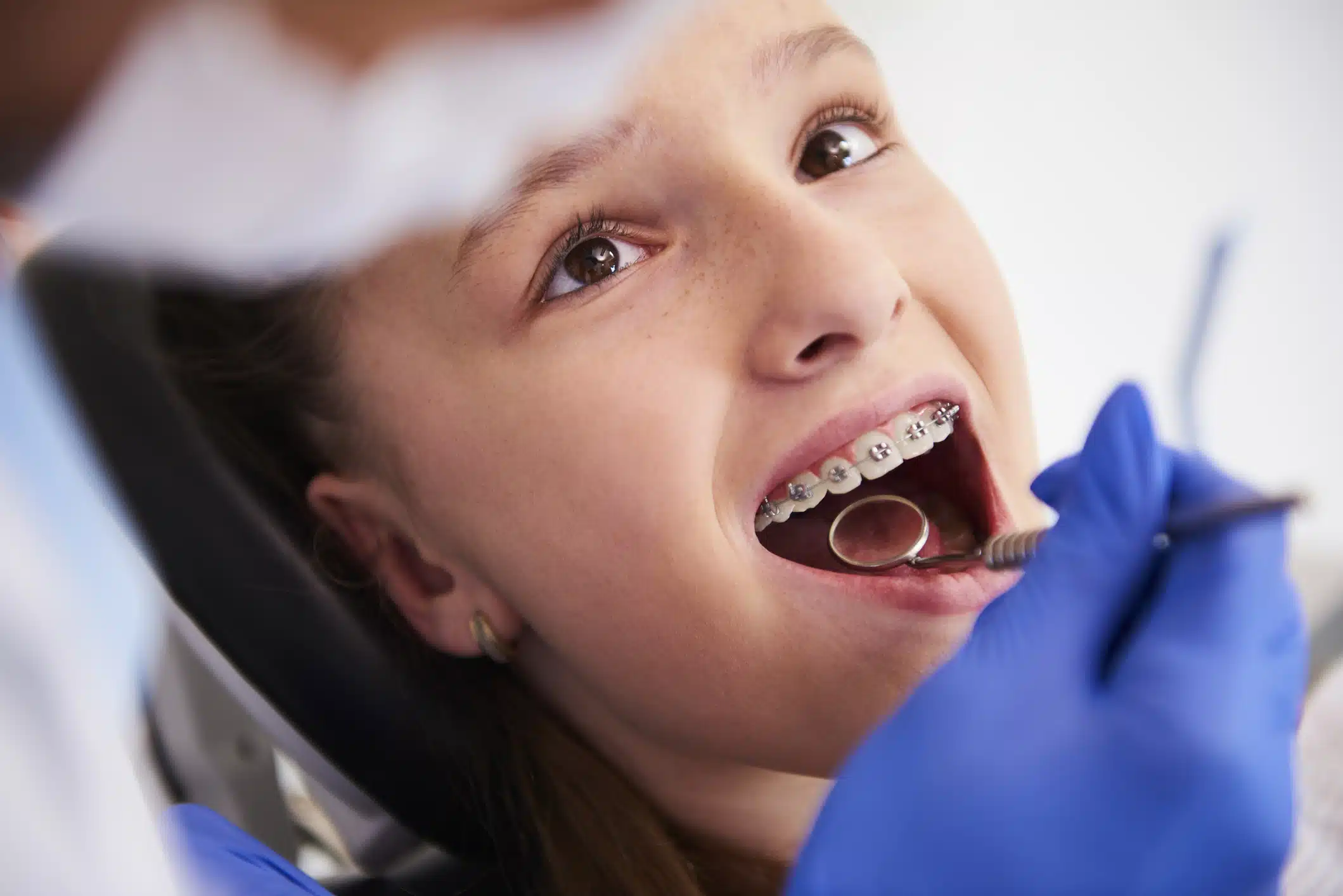Crowding, protruding teeth, and bite irregularities are surprisingly common in school-aged children in Mona Vale and across Sydney’s Northern Beaches. The good news is that an early orthodontic assessment can identify these issues while your child is still growing. When caught early, orthodontic treatments can gently guide their teeth and jaws into healthier positions and lay the foundation for a lifetime of confident smiles.
As a parent, you might wonder whether braces are in your child’s future and what that journey might look like. You are certainly not alone. This guide explains the common signs that braces may be needed, the best timing for treatment, the step-by-step process, and practical tips for everyday life with braces. Our caring team at Beaches Dental Mona Vale are here to support you and your little one through every stage, from the first orthodontic visit through to the day the final retainer goes in!
Does My Child Need Braces?
Every child develops at their own pace, and the progression from baby teeth to adult teeth is an important period for facial growth and smile development. Some orthodontic problems are obvious, while others surface only as permanent teeth arrive. If your child’s teeth or bite do not seem quite right, an early check can provide peace of mind.
You might notice the following signs:
• Crowding or overlapping front teeth
• Early or late loss of baby teeth
• Protruding upper teeth
• Crossbite, underbite or deep overbite when the jaws close
• Difficulty chewing or speaking clearly
• Mouth-breathing or snoring at night
• Thumb-sucking or dummy use beyond four years
Some issues run in families, while others, such as habits, early loss of baby teeth or injury, develop unexpectedly. If you notice any of these concerns, or your dentist flags them during a check-up, it’s best to arrange an orthodontic assessment.
Best Age for an Orthodontic Check
The Australian Society of Orthodontists recommends a first orthodontic review around age seven. By this stage, the permanent front teeth and first adult molars have usually erupted, offering a clear view of how the bite is developing. Seeing an orthodontist at this age does not necessarily mean treatment starts straight away; for many children, the initial assessment simply means monitoring and planning.
Typical Treatment Time-Frames
• Ages 7–10: Early (phase-one) treatment if there is severe crowding, a crossbite or jaw-growth concern. Appliances at this stage may be simple expanders or partial braces that guide the jaws as they grow.
• Ages 11–14: Most comprehensive orthodontic treatments (full braces) start during this period, after most adult teeth are in place. This is the most common time for traditional braces.
• Ages 15+: Older teens and adults who missed earlier care, or those who need fine-tuning, can still achieve excellent results with braces or aligners.
At each stage, we help you choose the best timing, balancing early action with your child’s growth, comfort and social needs.
Your Child’s Orthodontic Journey at Beaches Dental Mona Vale
Every child’s smile is unique, so we tailor the process to match their needs, lifestyle and goals.
Initial Consultation
The first visit is relaxed and friendly. We discuss your concerns, take digital photos and any X-rays they may need. We may also take 3-D scans with our digital scanner, no messy impressions needed. You receive a personalised treatment plan outlining the recommended approach, expected time-frame and costs. We encourage both parents and children to ask questions at every step.
Preparation
Before braces go on, we ensure all teeth and gums are healthy. If any baby teeth need to come out, or there is active decay or gum inflammation, we treat these first. Some children need small separators or molar bands placed a week before the main appointment.
Having Braces Fitted (60–90 Minutes)
On the big day, teeth are cleaned, a gentle conditioner is applied, and precision-placed brackets are fixed onto each tooth. A thin archwire is then attached to guide movement. Kids can personalise their braces with coloured elastic modules, a great way to express their personality and make the experience fun!
Regular Adjustments
We usually will see your child every 4–10 weeks to keep treatment on track. At each visit, wires and/or elastics may be changed, and we check their progress too. We may also take some quick new photos to record and monitor their progress. Most appointments are short, straightforward and a chance to celebrate how far your child has come.
Braces Off
When treatment is complete (typically after 18–24 months), the braces are gently removed, and the teeth are polished for that big reveal. We then fit custom retainers to lock in their new smile.
Retainer Phase
Retainers are worn full-time at first, then only at night. In most cases, we will also bond a fixed retainer behind the front teeth for extra protection from tooth movement. We support you throughout, with clear guidance on retainer wear and maintenance.
Types of Braces for Children and Teens
Orthodontics is no longer one-size-fits-all. We help families select the option that best suits their lifestyle and personality.
Traditional Metal Braces
Today’s metal braces are smaller, smoother and more comfortable than ever. They treat all levels of crowding or bite concerns effectively. Monthly visits to pick new elastic colours turn each adjustment into something fun.
Ceramic (Tooth-Coloured) Braces
These brackets blend with the natural tooth shade and are custom made for your teeth. They are popular with image-conscious teens who prefer a subtle look. They are just as efficient as metal braces for most cases, but may need a little extra care to avoid breakage.
Self-Ligating Braces
These systems use sliding clips instead of elastic ties, which can make cleaning easier and may hep to reduce appointment times.
Clear Aligners
Removable aligners such as Spark® and Invisalign® offer a discreet alternative for motivated kids and teens with mild to moderate alignment needs. They must be worn most of the day, so discipline is essential for great results.
Unsure which option is best? We will walk you through the pros and cons at your first visit so that you and your child feel confident in the choice.
How to Care for Braces
Oral hygiene and a braces-friendly diet are key for healthy, trouble-free treatment. With a few simple adjustments, caring for braces can soon become second nature.
Oral Hygiene
Children should brush after every meal with a soft-bristle or electric toothbrush and fluoride toothpaste, paying special attention to the gumline and around brackets. Interdental brushes or even better a water flosser can help remove food and plaque from between the teeth and under the wires. We recommend professional cleans every 3–6 months, depending on your child’s oral hygiene routine and if they have had fillings or a history of gingivitis.
Food Guide
Crunchy apples, sticky lollies, popcorn and hard foods like nuts can break braces or get trapped around brackets and wires. Choose soft fruits, steamed veggies, pasta, yoghurt and chocolate that melts easily. Encourage your child to cut food into small pieces (sandwiches and wraps are easier than crusty bread rolls).
Comfort Tips
It is normal for braces to feel tight or tender during the first few days after placement or an adjustment. Offer soft foods, chilled drinks and over-the-counter pain relief if needed. Orthodontic wax eases any bracket or wire irritation. Keep spare elastics in your child’s school bag, and contact our Mona Vale practice if anything feels uncomfortable or if a wire starts poking or causing irritation. We’re always here to help.
Cost, Health Funds and Payment Options
We understand that orthodontic treatment is an investment for families. Our fees are fully explained, with all-inclusive quotes before you begin. Several factors affect cost: the complexity of your child’s case, the chosen appliance and the expected treatment duration.
- Many private health funds include orthodontic rebates (usually spread over the course of treatment).
- The Child Dental Benefits Schedule covers dental exams and some basic treatments for eligible children, although it does not include braces.
- We offer flexible, interest-free payment plans that spread payments across the treatment period, easing pressure on the family budget.
If you have questions about rebates or payments, our reception team is ready to help.
Why Families Choose Beaches Dental Mona Vale
Choosing the right orthodontic care is important. At Beaches Dental Mona Vale, you have access to a caring, highly qualified specialist orthodontist, Dr Anastasia Bakopoulou, who treats patients of all ages, delivering care in a warm, encouraging style that helps children and adults alike feel at ease. We use modern digital scanners for mess-free impressions, offer after-school and holiday appointments, and provide general dental care in one convenient location.
Our team is here to celebrate every milestone with your child, from the first day with braces to the excitement of their “braces off” reveal.
Ready to Book Your Child’s Orthodontic Assessment?
Early orthodontic action can mean less time in braces, simpler treatment and a lifetime of confident smiles. To schedule your child’s orthodontic assessment at Beaches Dental Mona Vale, call us at (02) 9997 8822 or request an appointment online today.

